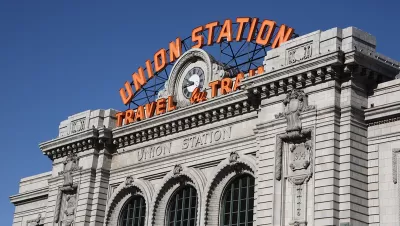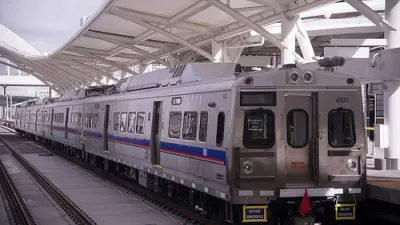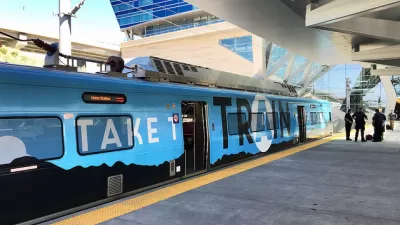You will be forgiven for thinking you are looking at an East Coast commuter rail line: It's electrified with level boarding, mostly 15-minute headways, with bike and luggage racks, operating 22 hours a day from Denver's Union Station to the airport.

Don't look for the "Train to the Plane" at Union Station. Instead, "it goes by name 'RTD University of Colorado A Line', which takes its name as a result of the first sponsorship through the Regional Transportation District's naming rights program," states Monte Whaley of The Denver Post (listen and watch here). During construction, it's referred to as the East Line.
Public-private partnership, cost, rail cars
The highly anticipated line is electric commuter rail, which is part of the Eagle P3 project, the nation's first full public-private partnership for transit.
As a June 2010 Planetizen post on the project indicates, "RTD board voted 13-0 to select a team called Denver Transit Partners, composed of "Fluor Enterprises Inc., Australia's Macquarie Capital Group and transit contractor Balfour Beatty Rail Inc. to build and operate a $2.1 billion portion of FasTracks". They will operate the line for 40 years."
"Local RTD taxes combined with a $1.03 billion federal grant and $450 million from Denver Transit Partners — the 34-year concessionaire that will build, operate and maintain the trains," writes Whaley.
According to an RTD FasTracks fact sheet (pdf) on the electric commuter rail vehicles and service that includes a comparison to light rail, the vehicles will be manufactured by Hyundai Rotem USA which calls them electric multiple units, or EMUs (not to be confused with the Australian ostrich-like bird).
[Note East and West Coast issues that have arisen with Hyundai Rotem commuter rail cars].
Days, hours and frequency of operation; stops and fares
Whaley writes that the fare for the 23-mile, 37-minute trip to the airport from Union Station is $9. RTD's A Line webpage indicates that the seven-day, 22-hour service and frequencies are truly oriented for airport travel:
-
3 - 6 a.m., every dayService every 30 minutes
-
6 a.m. - 8 p.m., every dayService every 15 minutes
-
8 p.m. - 1 a.m., every dayService every 30 minutes
Commuter rail will operate on a zone-based fare. There are seven stations in three zones, plus the airport (DIA) in its own zone, according to the fares page:
RTD indicates that the A Line will bring "train service into new neighborhoods and employment areas along Interstate 70."
With the inception of the new rail service to DIA in April, expect the airport's low accessibility rating to improve.
In addition to the A Line, look for two new electrified commuter rail lines to be opening next year: Gold Line and the first segment of the Northwest Rail. A fourth line will open in 2018.
Hat tip: Annie Dawid.
FULL STORY: RTD announces Union Station-to-DIA rail line will open April 22, 2016

Alabama: Trump Terminates Settlements for Black Communities Harmed By Raw Sewage
Trump deemed the landmark civil rights agreement “illegal DEI and environmental justice policy.”

Study: Maui’s Plan to Convert Vacation Rentals to Long-Term Housing Could Cause Nearly $1 Billion Economic Loss
The plan would reduce visitor accommodation by 25% resulting in 1,900 jobs lost.

Why Should We Subsidize Public Transportation?
Many public transit agencies face financial stress due to rising costs, declining fare revenue, and declining subsidies. Transit advocates must provide a strong business case for increasing public transit funding.

Paris Bike Boom Leads to Steep Drop in Air Pollution
The French city’s air quality has improved dramatically in the past 20 years, coinciding with a growth in cycling.

Why Housing Costs More to Build in California Than in Texas
Hard costs like labor and materials combined with ‘soft’ costs such as permitting make building in the San Francisco Bay Area almost three times as costly as in Texas cities.

San Diego County Sees a Rise in Urban Coyotes
San Diego County experiences a rise in urban coyotes, as sightings become prevalent throughout its urban neighbourhoods and surrounding areas.
Urban Design for Planners 1: Software Tools
This six-course series explores essential urban design concepts using open source software and equips planners with the tools they need to participate fully in the urban design process.
Planning for Universal Design
Learn the tools for implementing Universal Design in planning regulations.
Smith Gee Studio
Alamo Area Metropolitan Planning Organization
City of Santa Clarita
Institute for Housing and Urban Development Studies (IHS)
City of Grandview
Harvard GSD Executive Education
Toledo-Lucas County Plan Commissions
Salt Lake City
NYU Wagner Graduate School of Public Service






























